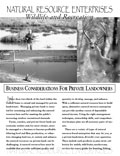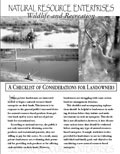Start a Business
Manage a Business
Business Types
Writing a Business Plan
Writing your business plan will help you weigh the costs of doing business against the potential market demand, and help you determine the feasibility of the enterprise, the time required to get the business up and running, and the amount of time it will take to make the operation profitable and to become an integral part of your total operation.
Your local Small Business Development Center, Extension office, and the U.S. Small Business Administration are all valuable resources when writing a business plan.
Outline for a Business Plan
- Introduction and 3- to 5-year plan for the business
- Marketing plan
- Operating plan
- Organizational plan
- Financial plan, including the feasibility perspective
- Evaluation and monitoring plan
Introduction
Your introduction should explain and describe the types of business you are proposing.
- Include a summary of why you are considering the enterprise and the history behind the creation of it.
- Develop a mission statement for the enterprise and include it in this section.
- List clear and concise objectives that can be measured to evaluate the progress and success of the plan.
- Develop a timetable for accomplishing specific objectives identified.
- Include general information about the demand for the products, services, or access associated with the enterprise.
- Include information known about the growth of this type of enterprise statewide and nationally.
Marketing Plan
Before writing a marketing plan, you need to perform market research by
- identifying several different possibilities for marketing the enterprise
- visiting other enterprises and talking with enterprise owners
- reading trade journals related to your industry
- get information about your proposed business from Extension personnel and other agencies such as the SBDC
Once you have done the market research, develop a plan of action to attract customers. Marketing plans include the tools you will use to advertise your business (newspaper ads, radio ads, a website, etc.), the groups you will advertise to (ages, family stage, expendable income, etc.), a way to measure the success of your marketing (surveys, website tracking, questionnaires), an annual budget, pricing your services/offers and more. Read the publication Business Considerations for Private Landowners for more information.
Operating Plan
This section of the business plan details what the business provides:
- Describe a normal working day for the enterprise.
- Provide a physical address for the enterprise.
- Tell where the enterprise is located and the most direct way to get to it.
- Give a mailing address if different from the physical address.
- Include telephone and fax numbers.
- Identify by name, who the contact person(s) will be.
- Provide by e-mail or web site, if available.
Organizational Plan
This part of the plan should be a chart showing the chain of command for operating the enterprise with a description of duties and responsibilities of each employee. Include resumes for the managers and owners. Include any special skills, training, experience, or education that employees have the benefit the business. Discuss what benefits employees will receive. Read the publication Business Considerations for Private Landowners for more information.
Financial Plan
The financial plan for your business must consider budgeting of the enterprise. It includes four parts: a statement of sources and uses, a profit and loss statement, a cash flow statement, and a balance sheet. Read the publication Business Considerations for Private Landowners for more information.

Business Considerations for Private Landowners (PDF)
Mississippi State University Extension Service
Mississippi State University Extension Service. The first step to planning a natural resource enterprise is writing up a business plan to determine if the business is realistic. Next, determine what physical, financial and labor recourses are available. Marketing, organizational and financial plans are necessary to determine if the business will succeed.

A Checklist of Considerations for Landowners (PDF)
Mississippi State University Extension Service
This is a list of things to consider before starting a natural resource enterprise. It includes the determining what resources are available, such as land and buildings and wildlife populations, determining if the land’s natural resources can be used for more than one purpose and if a sufficient labor force is available, liability insurance, how long the enterprise will last, the willingness of the family to participate in the enterprise, finding customers, the location of the business and how easy it is to access, and creating a business plan. A worksheet is provided to help evaluate the success of a potential natural resource enterprise.
Checklist for Starting a Value-Added Agriculture Enterprise (PDF)
NC State University
This checklist covers the areas to consider when researching the possibility of undertaking a value-added agricultural enterprise.

